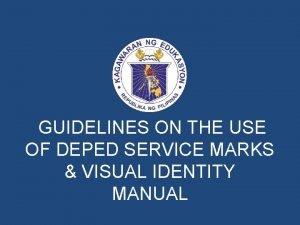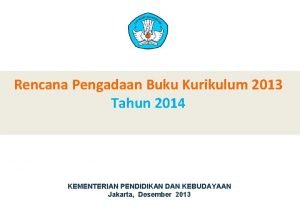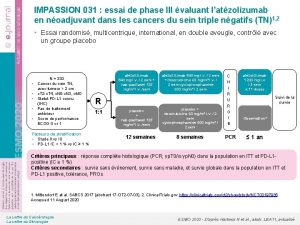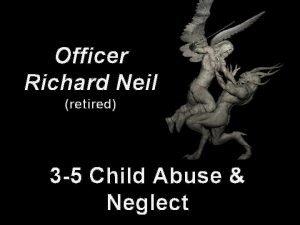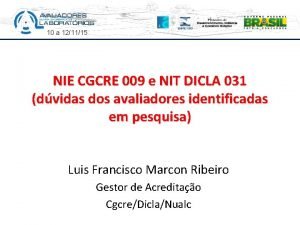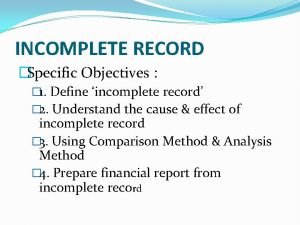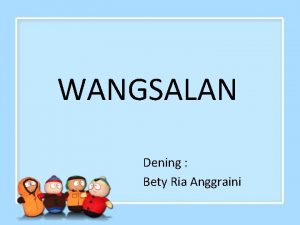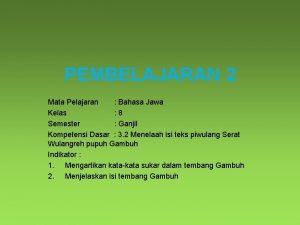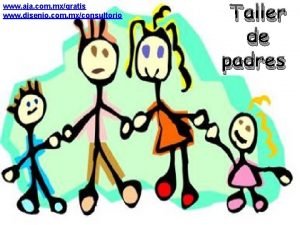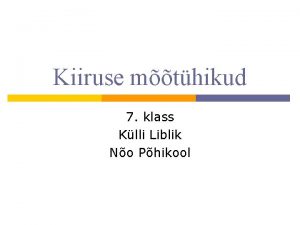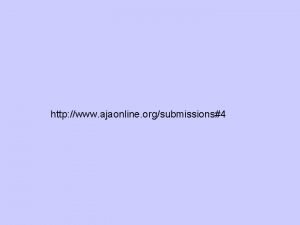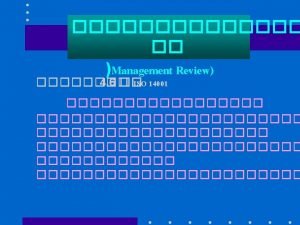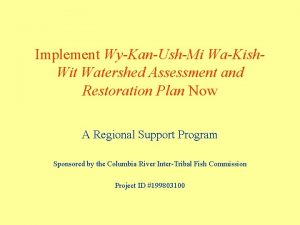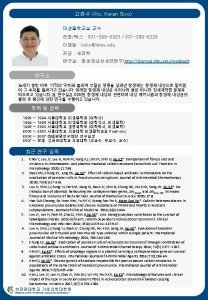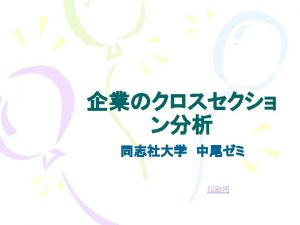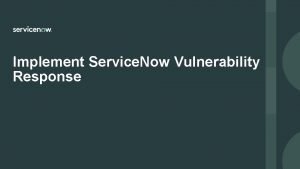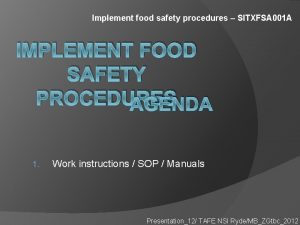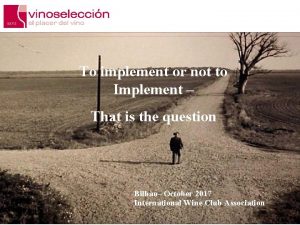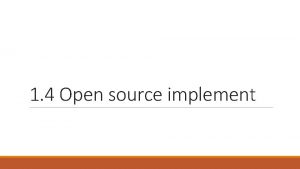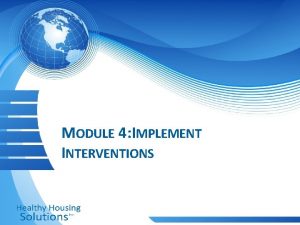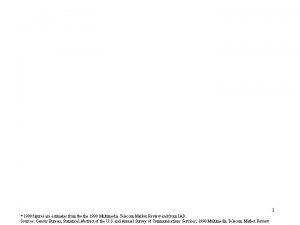Implement WyKanUshMi WaKishWit Project 1998 031 00 Aja














- Slides: 14

Implement Wy-Kan-Ush-Mi Wa-Kish-Wit Project #: 1998 -031 -00 Aja De. Coteau, CRITFC Watershed Department Manager 1

To ensure a unified voice in the overall management of the fishery resources, and as managers, to protect reserved treaty rights through the exercise of the inherent sovereign powers of the tribes.

Four Tribes’ Ceded Lands Combined 66, 591 total square miles More than 25% of the entire Columbia Basin 55% of the rivers and streams still accessible to salmon YN NPT CTUIR CTWSR 3

Wy-Kan-Ush-Mi Wa-Kish-Wit Spirit of the Salmon Tribal Restoration Plan (TRP): 1995 -2020 “Put fish back in the rivers…and protect the watersheds where fish live. ” Provides a framework for restoring anadromous fish stocks throughout their lifecycle (Salmon, Pacific lamprey and White Sturgeon) in upriver areas above Bonneville Dam Incorporates protection of treaty rights, habitat protection and restoration, natural production, holistic decision-making and recommendations for technical and institutional issues. 4

Wy-Kan-Ush-Mi Wa-Kish-Wit Spirit of the Salmon Tribal Restoration Plan (TRP): 1995 -2020 “Put fish back in the rivers…and protect the watersheds where fish live. ” 7 years: Halt the decline of salmon, sturgeon and lamprey upstream of Bonneville Dam. 25 years: Increase total adult salmon returns above Bonneville to 4 million annually and in a manner that sustains natural production to support tribal fisheries. 25 years: Increase sturgeon and lamprey populations to naturally sustainable levels that supports tribal harvest. 5

Wy-Kan-Ush-Mi Wa-Kish-Wit Spirit of the Salmon Brief History of Project began in 1998 based on the need for regional coordination among the CRITFC tribes in implementing Wy-Kan-Ush-Mi Wa-Kish-Wit. Created Watershed Department Utilizes adaptive management framework Provides technical, policy, funding & outreach assistance to CRITFC tribes Accord project as of 2008 6

Wy-Kan-Ush-Mi Wa-Kish-Wit Spirit of the Salmon Objective 1: Implement Tribal Restoration Plan (TRP) Project administration Regional coordination: Ensure goals and principles of TRP are implemented in regional decision-making processes. Tribal coordination: Coordinate and improve the implementation of tribal projects using adaptive management principles in response to updated science, technology & policy. Technical review: Provide technical, scientific, funding & policy coordination in preparing, reviewing & implementing strategies that integrate TRP principles into BPA’s Fish & Wildlife program. 2012 Update to TRP 7

Wy-Kan-Ush-Mi Wa-Kish-Wit Spirit of the Salmon Objective 1: 2012 Update of Tribal Restoration Plan Updated Goals and Objectives Updated Legal and Cultural Framework Overview of tribal successes and accomplishments Inclusion of emerging issues: legal, scientific, technical, policy-related, biological, etc. Overview of achievements and obstacles Updated Policy and Technical Recommendations 8

Wy-Kan-Ush-Mi Wa-Kish-Wit Spirit of the Salmon Objective 2: Provide coordination & outreach for the tribes Tribal coordination: • • • Priorities established by the Commission Provide tribal representation at regional forums, meetings & workgroups & report back to the Commission and tribes Advocate for implementation and collaboration of tribal projects & respond to emerging issues Outreach and Education: • Tribal workforce development program • Development of outreach materials 9

Wy-Kan-Ush-Mi Wa-Kish-Wit Spirit of the Salmon Brief synopsis of accomplishments Developed 2002 calendar of tribal restoration projects and distributed 2000 copies Participation in development of 2007 “Regional Coordination for the Fish & Wildlife Program Today & Tomorrow” document Updating CRITFC website: maps of tribal restoration projects Coordinated tribal response on regional issues: HSRG, Supplementation, etc. June 2011 Future of Our Salmon: A Vision of Restoration in the Columbia River Basin 2011 Future of Our Salmon conference: Executive Panel 280 Registrants, 70 Evaluations received, 32 presentations, 16 Poster presentations, media coverage from 5 outlets & all post-conference 10 material accessible on CRITFC website

Wy-Kan-Ush-Mi Wa-Kish-Wit Spirit of the Salmon How does this project fit into work in the Basin? Provides coordination & tracking of projects, programs and funding sources in the Basin. Ensures coordination of projects to reduce overlap. Facilitates, participates and represents tribal interests in local, regional and national forums. Provides technical and outreach assistance to tribes and agencies. Provides outreach and education to tribes, outside agencies and the public about tribal recovery efforts. Tribal restoration projects 11

Wy-Kan-Ush-Mi Wa-Kish-Wit Spirit of the Salmon Future Work Oct. 17 -18, 2012 Future of Our Salmon conference with a focus on Hatchery Policy June 2012 Toxics Reduction Workshop Development of strategies to respond to emerging issues such as: • Hatchery policy, toxics reduction/water quality, tribal workforce development, legislation, Bi. Op, climate change, etc. Update of TRP in 2012: Provide analysis of progress in achieving the original goals & objectives and will develop future recommendations Nez Perce Tribal Hatchery 12

Wy-Kan-Ush-Mi Wa-Kish-Wit Spirit of the Salmon How are we measuring success? Progress towards TRP goals & objectives: (Halt the decline, 4 million by 2020) Protection of tribal sovereignty & treaty rights Salmon decline: 1855 -2010 Returning Columbia River salmon (Chinook, steelhead, sockeye, Coho) Preserving tribal institutional capacity and leadership to deliver on the ground projects Improved trends of target species and populations ~17, 000 Improved ecosystems and watersheds Safeguarding tribal leadership role in Basinwide coordination efforts Sustaining and building partnerships 1, 754, 334 1995 -present 13

Wy-Kan-Ush-Mi Wa-Kish-Wit Spirit of the Salmon Conclusions Coordination: “the Sovereign’s ability to represent their interests and engage in the processes that affect those interests as they relate to the Columbia River Fish & Wildlife Program. ” (Regional Coordination for the F&W Program Today and Tomorrow, 2 007) Type of coordination: “wholly dependent on the work that needs to be accomplished and the particular entities identified that need to work together to accomplish it. ” (NPCC Program Amendments, 2009) CRITFC coordination continues to evolve as: 1) tribes continue to build capacity within their fisheries programs and 2) priorities within the Commission and tribes change to respond to emerging issues. 1 st Anniversary of Fish Accords 14

